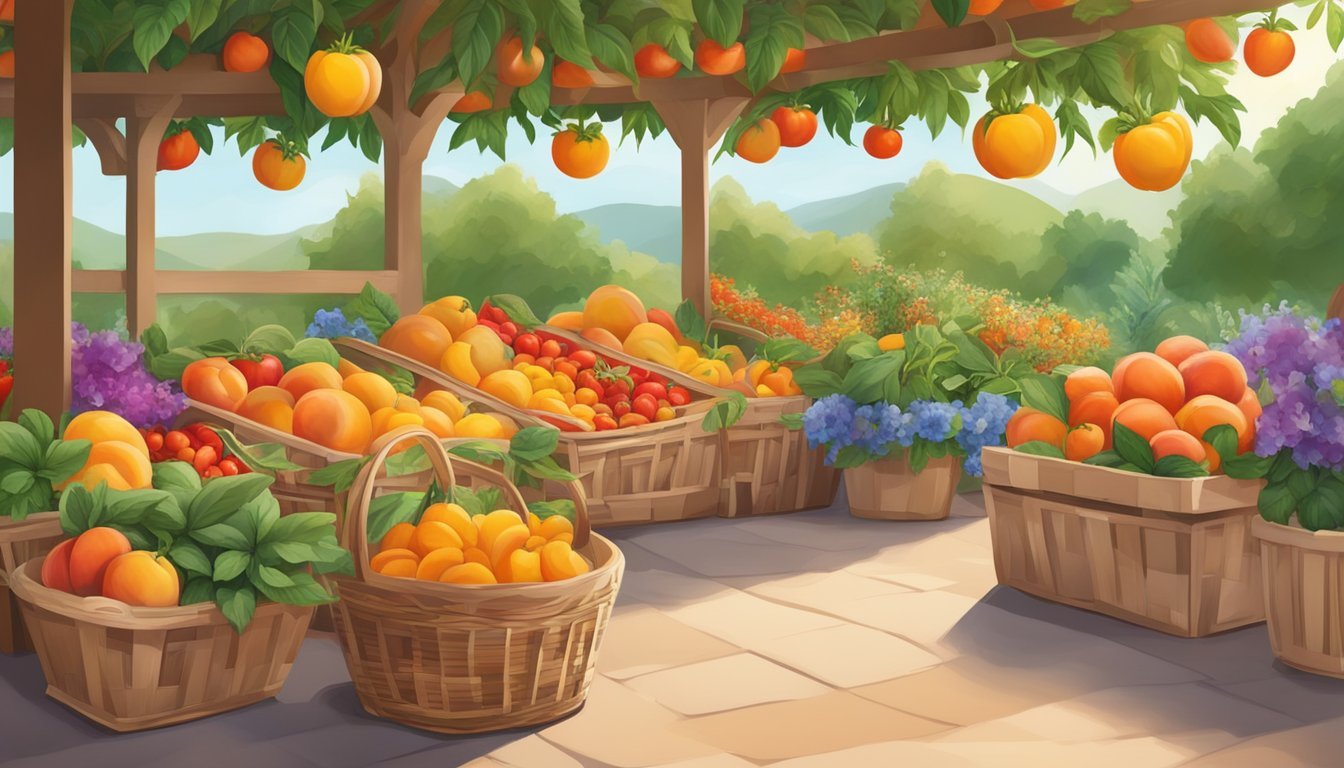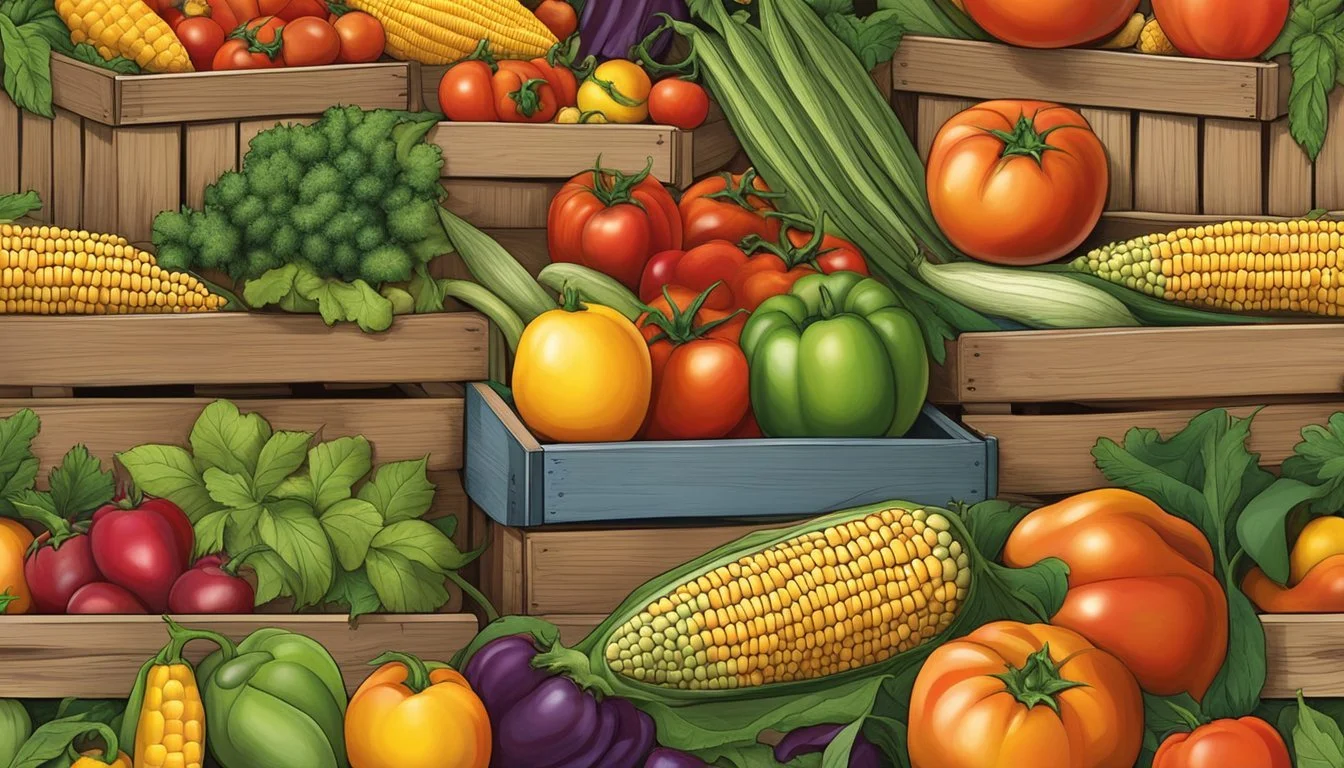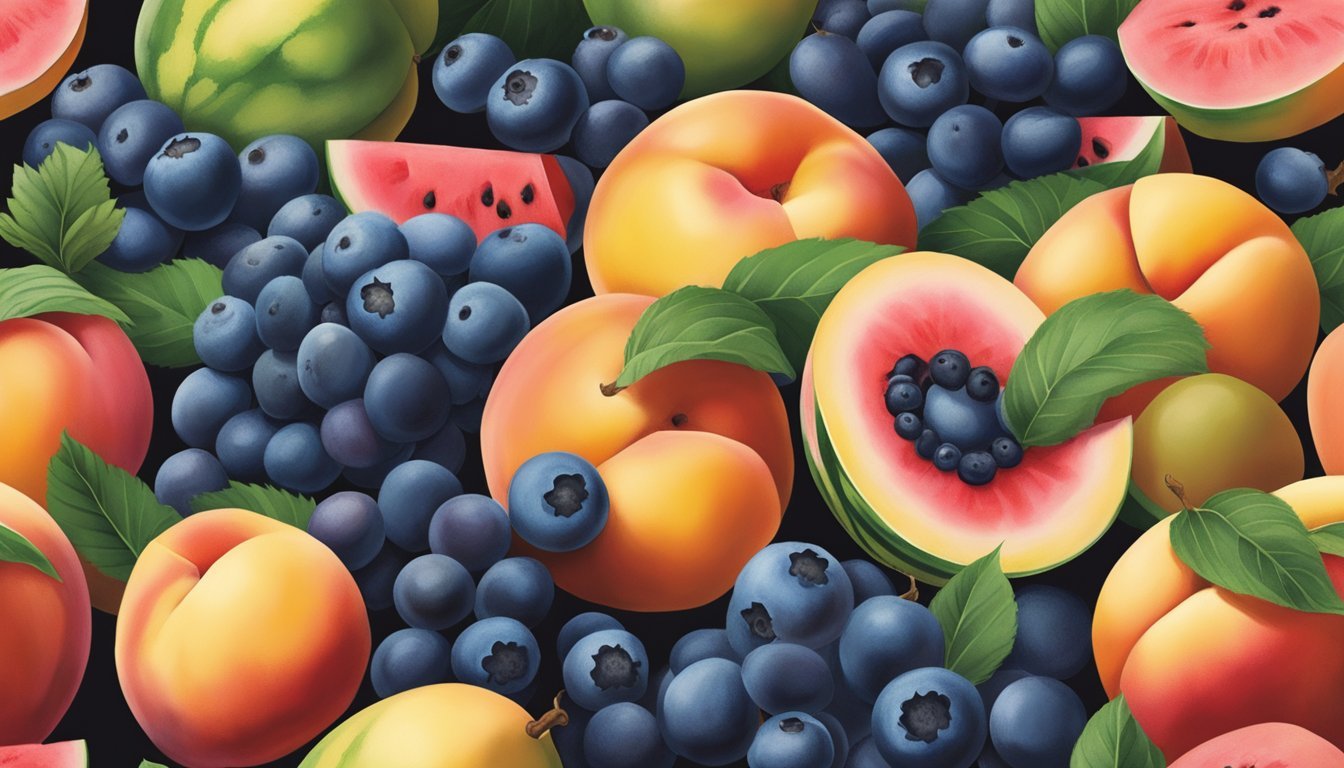Georgia Seasonal Fruit & Vegetables in September
Your Guide to Fresh Picks
This Article is Part of our Georgia Seasonal Fruit & Veg Calendar
In the rolling hills and sprawling plains of Georgia, September brings a shift in the agricultural tapestry. As summer begins to yield to fall, this transitional month offers a variety of fresh and nutritious produce. Georgia's climate and fertile soil create ideal growing conditions for a bounteous harvest, allowing for a rich selection of fruits and vegetables.
During this month, local markets and farms display an array of vibrant colors from the fresh produce available. Fruits such as muscadines and apples reach peak ripeness, offering sweet and tart flavors perfect for both fresh eating and culinary creations. Vegetables like okra, peppers, and sweet potatoes begin to take center stage, ready to be incorporated into hearty dishes suitable for the cooler evenings.
Georgia's September produce not only supports the state's agricultural economy but also provides consumers with the opportunity to enjoy the freshest possible flavors. Eating seasonally ensures that the fruits and vegetables are at their nutritional best, harvested at the perfect time for optimal taste and quality.
Overview of Georgia's Seasonal Produce
In September, the Peach State boasts a rich variety of produce due to its diverse climate and agricultural expertise, which support a wide range of fruits and vegetables during this month.
The Importance of Seasonality
Seasonal eating in Georgia reflects not just a tradition but also a strategic approach to agriculture. Eating seasonally ensures that consumers receive produce at its peak in both flavor and nutritional value. Moreover, seasonal crops dovetail with the state's environmental conditions, supporting sustainable farming practices and local economies.
Georgia's Agricultural Profile
Georgia's agriculture extends beyond the famed peaches and into a bounty of fruits and vegetables. The state's unique regional climates allow for an extended growing season, making it one of the nation's most versatile agricultural producers. The variety of crops includes, but is not limited to, tomatoes, cucumbers, squash, peaches, and berries.
September Weather and Crop Conditions
September in Georgia marks a transitional period where the warm summer begins to give way to milder fall conditions. Average temperatures slightly drop and the risk of freezing is minimal, creating an ideal environment for both late summer and early fall crops. These conditions contribute to the final maturation of summer produce and the beginning of fall harvests.
Planning and Planting Cycles
Georgia's farmers are adept at planning and adjusting their planting cycles to align with the state's seasonal weather patterns. By September, they harvest summer crops and prepare for the fall planting of cool-weather vegetables. The cyclical nature of planting and harvesting ensures a constant supply of fresh produce throughout the year.
Summer Crops
Tomatoes
Peaches
Berries
Transition to Fall Crops
Squash
Apples
Leafy Greens
Vegetables in Season
As September arrives in Georgia, a variety of vegetables reach their optimal freshness and flavor, offering a diverse palette for seasonal cooking.
Root Vegetables and Cruciferous Varieties
Georgia's September soil yields a rich harvest of root vegetables including sweet and earthy beets, crunchy carrots, spicy radishes, and hearty turnips. Cruciferous vegetables such as cabbage, cauliflower, and broccoli are also in peak season, providing an array of options for nutritious dishes.
Leafy Greens and Salads
Leafy greens flourish during this time, offering a variety of textures and flavors. Kale and spinach, both packed with nutrients, are readily available. The state also sees a bounty of collards, essential for southern cooking, and arugula, with its peppery bite perfect for salads.
Summer to Fall Transitional Vegetables
The transition from summer to fall brings vegetables that bridge the seasons. These include tender green beans, plump eggplants, crisp cucumbers, and versatile zucchini and squash. Corn maintains its sweet freshness, while peppers continue to add a splash of color and heat to dishes.
Herbs and Aromatic Produce
Aromatic herbs such as basil thrive in September's climate, enhancing the flavors of numerous recipes. Garlic, a staple in many cuisines, is harvested and offers its pungent zest to an array of culinary creations, while other herbs like parsley and cilantro provide fresh, bright notes.
Fruits in Season
September in Georgia is a bountiful month, presenting a diverse array of ripe fruits perfect for the picking. The warm days and cool nights create an ideal environment for the final waves of summer fruits and the welcoming of fall's sweet offerings.
Stone Fruits and Berries
Peaches and plums, synonymous with Georgian agriculture, are tapering off as September winds down, but they can still be found juicy and ripe in the early part of the month. It’s the last chance to enjoy these succulent stone fruits fresh from local orchards.
Peaches: Available but nearing the end of their season.
Plums: Ripe and ready, look for them early September.
Melons and Tropical Tastes
Georgia's warm climate supports the growth of lush melons well into September. Cantaloupes (how long does cantaloupe last?) and watermelons are still found in abundance, with their refreshing qualities being a staple at many picnics and gatherings.
Cantaloupes: Sweet and abundant.
Watermelons: Peak season continuing from summer.
Orchard Fruits and Late Berries
Orchard fruits take the spotlight as September progresses. Apples come into their prime, promising a variety of flavors and textures, while pears grow juicy and are perfect for both fresh eating and preserves. For berry enthusiasts, figs and muscadine grapes offer a taste of late summer sweetness.
Apples: A key fruit of the month, with many varieties available.
Pears: Sweet and succulent, ideal for an array of recipes.
Figs: Delicate and rich, often harvested in the latter part of the month.
Muscadine Grapes: A Southern specialty, ripe for the picking.
Harvesting and Storing
In September in Georgia, gardens and farms are brimming with produce ready for harvest. The focus this month is on techniques for harvesting and methods for preserving the bounty to extend its shelf life.
Best Practices for Harvest
Proper timing and method are crucial when it comes to harvesting. One should:
Harvest apples when they are firm and the skin color has turned from green to its ripe hue.
Pick Brussels sprouts after the first frost when they're firm and well-formed.
Collard greens are best harvested when the leaves are dark green, tender, and have reached a desirable size.
Harvesting in the cool morning hours is ideal to maintain freshness, reduce wilting, and extend the storage life of produce.
Storing for Freshness
Storage conditions vary depending on the produce:
Store apples in a cool, dark place or in the fridge where they can last for several weeks.
Brussels sprouts can be kept in the fridge in a container or a plastic bag for up to a few weeks.
Collard greens (how long do collard greens last?) should be wrapped in a damp paper towel and placed in the fridge for up to a week for optimal freshness.
It is important to avoid storing fruits and vegetables that emit ethylene gas near those that are sensitive to it, as this gas can accelerate ripening and spoilage.
Freezing and Canning
Preserving the harvest allows enjoying the flavors of September well into the winter months.
To preserve the harvest, one can:
Freeze fruits and vegetables by blanching them first to preserve texture and flavor. This method is great for beans and peas.
Canning is ideal for making jams, applesauce, or salsa. The high-acid content in fruits makes them suitable for water bath canning, while vegetables typically require pressure canning.
To maintain the best quality, use produce that is at peak ripeness and process immediately after harvesting.
Preservation not only extends the shelf-life but also locks in nutritional value, ensuring that the harvest continues to contribute to a healthy diet year-round.
Cooking and Preparation Tips
In September, Georgia's harvest offers a variety of fruits and vegetables that can enhance the flavor of many dishes. Cooking enthusiasts can explore an array of preparation methods to turn seasonal produce into delightful meals and preserves.
Seasonal Recipes and Pairings
When selecting dishes, a chef should consider combinations that complement the natural tastes of September's bounty. Apples and pears can be turned into tart pies or chopped into salads for a crunchy, juicy addition. Tomatoes, ripe and rich in flavor, are perfect for savory fried green tomatoes or fresh tomato-basil salads. Melons offer a refreshing note to dishes and can be paired with prosciutto for a classic melon and cured ham appetizer.
Preserves and Pickling
Georgia’s September produce is ideal for making jams, pickles, and canned goods. One can capture the essence of fresh peaches in a homemade peach jam, or transform cucumbers into crisp dill (how long does dill last?) pickles through canning. Vegetables such as peppers and eggplant can be preserved in oil or vinegar to create flavor-packed condiments.
Cooking Techniques for Fresh Produce
Fresh produce thrives with the right cooking technique. For instance, roasting brings out the natural sweetness in root vegetables while grilling can impart a smoky flavor to late-summer squashes and eggplants. When working with greens, lightly sautéing with garlic and olive oil retains flavor and nutritive value. Chefs can also bake vegetables into casseroles or frittatas for a comforting meal.
Where to Find Georgia's Seasonal Produce
In Georgia, September offers an abundance of fresh and locally-grown seasonal produce. One can find these items through various outlets, providing support to the local farmers and the community.
Farmers' Markets and Local Farms
Farmers' markets throughout Georgia are a hub for seasonal fruits and vegetables, often featuring the freshest picks from local farms. These markets allow consumers to purchase high-quality produce directly from the growers. In September, visitors to local farms and markets can expect to find items like apples and muscadines at their peak.
Farmers' Markets: These are ideal for a wide variety of fruits and vegetables.
Example: Atlanta's farmers' markets offer a vibrant and diverse array of fresh produce.
Local Farms: Many offer "pick-your-own" experiences.
Example: Southern Belle Farm in McDonough, where visitors can pick their own apples.
Grocery Stores and Organic Sections
Grocery stores in Georgia also stock seasonal produce, with many having distinct organic sections. These stores procure fresh produce from local sources, ensuring a supply of seasonal items that support the community's economy.
Grocery Stores: They typically have a section dedicated to local and seasonal items.
Local Produce Aisle: Here, one can find signage indicating produce grown in Georgia.
Organic Sections: These sections are specifically for consumers looking for organically grown options.
Certified Organic: Items here adhere to organic farming standards, ensuring no synthetic pesticides or fertilizers were used.








